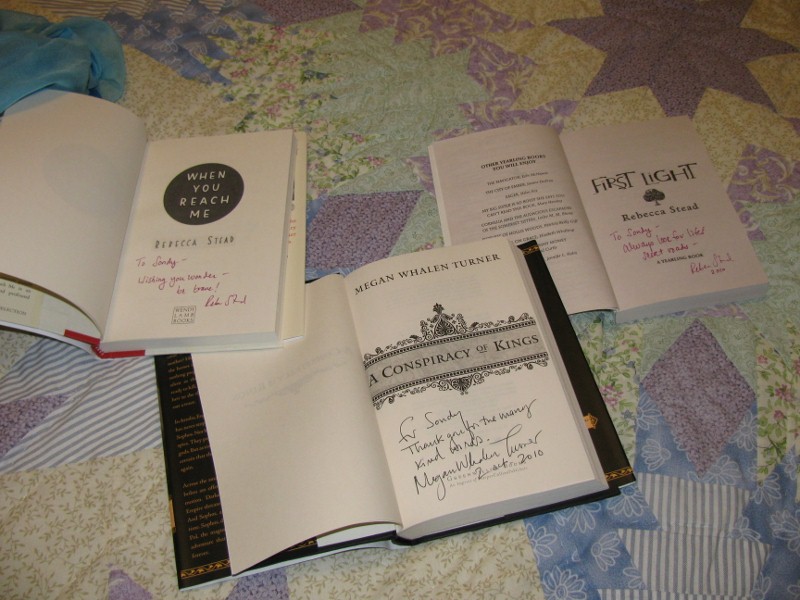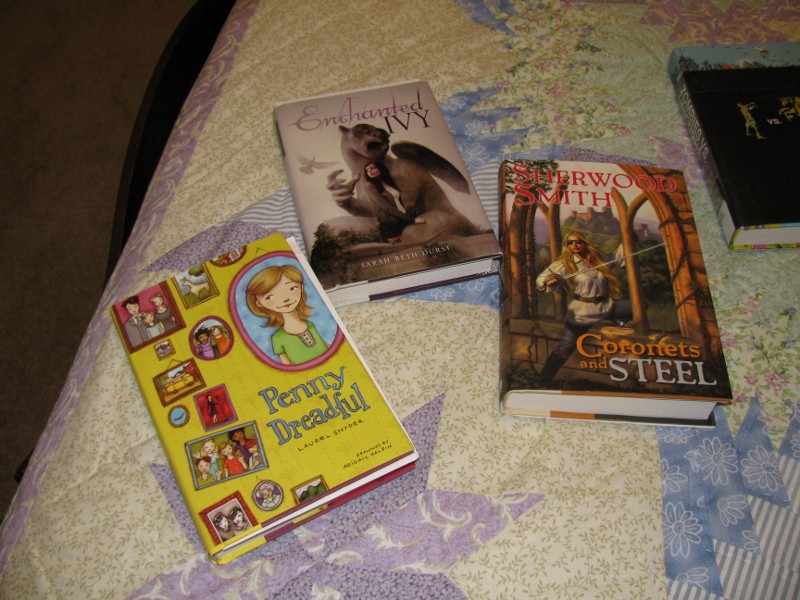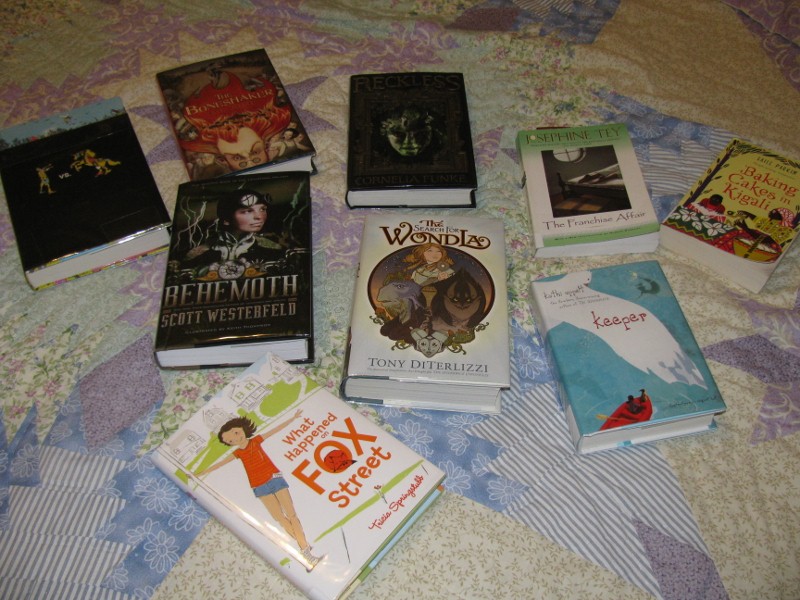Well, I just got back from Fairfax County’s budget forum, and I’m so discouraged I want to cry. I will try expressing some of my thoughts here, instead.
Now, I did get a chance to speak up for libraries — to say that the cuts they made in the last two years to the library system were totally unacceptable, bad for Fairfax County, and should be restored. But I felt like people just thought I was biased because I’d been RIF’d from the library. (For those who are lucky enough not to have experience with the acronym RIF, it stands for “Reduction in Force.” Back in June, I was cut from my position as a Youth Services Manager in a community library and placed in another county agency at the same paygrade as a Management Analyst I.)
Actually, I’m luckier than the people who did not get RIF’d — I have much, much better hours than people who still work for the library. They have to work until 9:00 pm two nights every week, and they have to work every other Saturday, and some every other Sunday. They have trouble scheduling vacations because staffing is so low, and they feel guilty if they’re too sick to work. What’s more, my new job is much, much less challenging, does not require a Master’s degree (I have two), and doesn’t supervise anyone or have to set up a program schedule or have to serve the public or have to make decisions about weeding the collection. In other words, it’s something of a vacation from stress. (And I hope to get back soon — I hear that before long a Librarian I will retire.)
But I feel terrible about the library cuts because it is so terribly bad for the people of Fairfax County.
The worst part is that the people who are hurt most by the cuts are exactly the people who don’t have much of a political voice — the unemployed, children from families without internet access, the homeless, college students, home schooled families, parents of young children, immigrants who need to learn English, people who want to interact with the government but don’t have computers, and so many more. These people, the ones hurt worst, are exactly the sort of people who don’t tend to speak up in the political process. So that was why I felt the need to go to the budget forum and say my piece, since I do have a voice.
It’s frustrating. The county says that two of its top three priorities are Education and Human Services. Yet libraries serve both of those areas in a very cost-effective way, yet they are put in the category of “culture” and are therefore low priority. That’s nonsense! Libraries are all about education, and for EVERYONE, not just the children who use the public school system.
Though it also supports the public school system by giving students the resources to get their homework done and supporting their reading skills during the summer.
What’s more, libraries are one of the only places where you can get help without having to apply for it. This is help that preserves your dignity. Computers to apply for jobs. Help to apply for jobs. Research materials for classes. Consumer information. Programs that build early literacy and future success for babies, toddlers, and preschoolers. Not to mention free books!
Libraries are the one resource that really really helps the poor — but also helps the rich! Of course, the downside to that is that some rich people think that since it would be no hardship for them to go without the library, it’s also no hardship for anyone else. How wrong they are!
I wonder about our homeless regulars at my former library — what are they doing now that the library is open so much fewer hours. In the library, they could retain their dignity and use the computers and books like any other customer.
And every single day, even at a smallish branch, we got people using the internet to look for jobs and people asking for books to learn English. Not to mention the regular flow of children needing help with finding materials for a school assignment. I understand that the parents of babies are already asking why the library is not doing programs for them every week, but instead once a month, if that.
It’s because of BUDGET CUTS, folks!
When you’ve cut the number of librarians down to barely enough to keep the library open, you just can’t do as many programs. No more on Saturdays, which was great for working parents. For my former library, it’s down to the bare minimum.
What really added insult to injury was the news a couple weeks ago that the Board of Supervisors had carryover money — more money than had been anticipated — and they decided to put $24.9 million into a “rainy day fund against future budget shortfalls.”
What’s insulting about that was that this amount is EIGHT TIMES the amount they cut from the library system last year, $2.67 million. So it makes it look like all our sacrifices — the rotten hours, closing the doors on customers who need us — didn’t actually make any difference. In fact, that was a TINY, miniscule amount in terms of the overall budget — less than a tenth of one percent. But in the last two years, they have cut more than 30% from the library’s budget, and that has devastated the library system.
So, the one bright spot in the meeting tonight was when the Chairman of the Board of Supervisors was saying that the cuts they’ve already made are sustainable and long-term — but she specifically mentioned the cuts in library hours as an exception to that.
But otherwise, though I got to say my piece, I felt that those there simply don’t realize how vital libraries are to the poorer people of Fairfax County. That with a miniscule investment of money in terms of the big picture, we can restore the library funding and make a huge difference, for the better, in so many people’s lives.
Support education and human services in Fairfax County — Restore Library Funding!!!
“Cutting libraries in a recession is like cutting hospitals in a plague.” — Eleanor Crumblehulme
So you know it’s not just me, here are a few links about the value of libraries:
1) Libraries help the economy:
Many links on the economic value of public libraries:
http://stephenslighthouse.com/2010/04/06/the-value-of-public-libraries/
2) Libraries support education:
The Importance of Summer Reading: Public Library Summer Reading Programs and Learning
http://www.nysl.nysed.gov/libdev/summer/brief01.pdf
3) Libraries keep the gap between the information “haves” and “have nots” from getting too much wider:
Opportunity for All: How the American Public Benefits from Internet Access at U.S. Libraries
http://www.gatesfoundation.org/learning/Pages/us-libraries-report-opportunity-for-all.aspx
4) The important role of libraries in a democracy:
http://thoughtsofawannabelibrarian.wordpress.com/2009/02/05/public-libraries-and-democracy/
http://stephenslighthouse.com/2010/08/22/5203/
http://archive.ifla.org/IV/ifla66/papers/101-122e.htm
I could go on, but I should probably stop. If any of my readers is a Fairfax County resident, please send an e-mail to your member of the Board of Supervisors: http://www.fairfaxcounty.gov/government/board/
Also be sure to comment on the budget forum page: http://www.fairfaxcounty.gov/budgetinput/
Support Education and Human Services! Restore Library Funding!
Note: The opinions expressed here are entirely my own and do not in any way reflect the opinions of my employer.
 The Small Adventure of Popeye and Elvis
The Small Adventure of Popeye and Elvis



